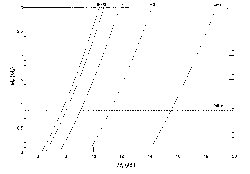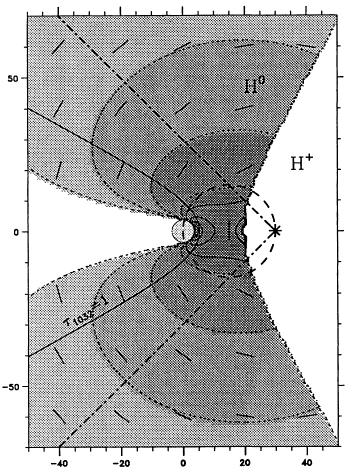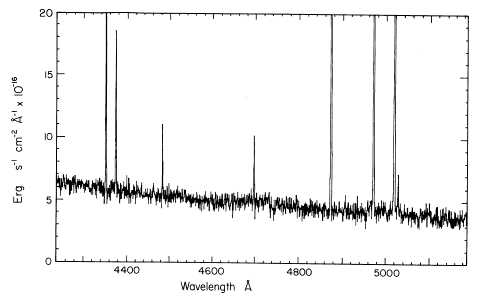|
GALAXIES
|
ACTIVE GALACTIC NUCLEI
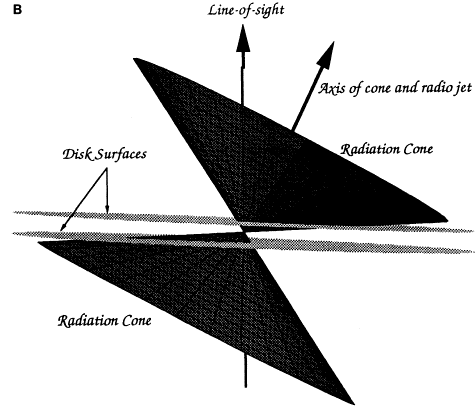 Active
galaxies appear in a wide variety of guises, with observed phenomena covering
vast ranges in luminosity and spatial scale. This diversity has hindered
attempts to understand the nature of the fundamental energy source. In
recent years, however, it has emerged that at least some of the radiation
produced by active galactic nuclei (AGN) is emitted anisotropically. This
has led to the development of "unified schemes" which seek to relate apparently
differently classes of AGN. In one model an active nucleus is largely enclosed
by a thick torus of obscuring material. The strong non-stellar continuum
and broad emission lines characteristic of Seyfert 1 galaxies are seen
when the object is oriented so that we have an unobstructed view of the
nucleus but when the obscuring disk is edge-on, the nucleus is hidden and
a Seyfert 2 galaxy is seen, with narrow emission lines and weak non-stellar
continuum. Active
galaxies appear in a wide variety of guises, with observed phenomena covering
vast ranges in luminosity and spatial scale. This diversity has hindered
attempts to understand the nature of the fundamental energy source. In
recent years, however, it has emerged that at least some of the radiation
produced by active galactic nuclei (AGN) is emitted anisotropically. This
has led to the development of "unified schemes" which seek to relate apparently
differently classes of AGN. In one model an active nucleus is largely enclosed
by a thick torus of obscuring material. The strong non-stellar continuum
and broad emission lines characteristic of Seyfert 1 galaxies are seen
when the object is oriented so that we have an unobstructed view of the
nucleus but when the obscuring disk is edge-on, the nucleus is hidden and
a Seyfert 2 galaxy is seen, with narrow emission lines and weak non-stellar
continuum.
As a test of these ideas, the
consortium called the "Lovers of Active Galaxies" observed the circum-nuclear
region of the Seyfert 1 galaxy NGC 4151, using both the WHT and INT as
part of and International Time Programme, looking for evidence of effects
on the surrounding interstellar medium of ionizing radiation emitted by
the nucleus. Like many Seyferts, NGC 4151 contains an extra-nuclear emission
line region (ENLR) which is elongated over several kiloparsecs. The LAG
consortium find that the ENLR emission line spectrum is characteristic
of photoionization by a AGN continuum source and that the ionizing radiation
field is very probably anisotropic.. Furthermore, the ionising parameter
decreases with distance from the nucleus, consistent with geometrical dilution
of the radiation of a central source. It is thought that ionising radiation
from the nucleus could be being emitted into a broad cone whose axis is
inclinned at a large angle to the plane of the galactic disk (by about
70 degrees) and that the ENLR is that segment of the disk which is illuminated
by the cone. An elongated nuclear radio source is obsserved at an angle
to the ENLR: the ejection axis of the radio-emitting plasma could conincide
with the axis of the cone. This geometry is consistent with the fact that
NGC 4151 is a Seyfert 1, since our line of sight would fall within the
cone, giving a direct view of the nucleus.
|
| More
information
ING facilities involved:
-
Isaac Newton Telescope,
using IDS
-
William Herschel Telescope,
using ISIS
Some references:
-
Robinson, A. et al,
1994, "The extended narrow line region of NGC 4151", A&A, 291,
351
|
|
SHELL GALAXIES
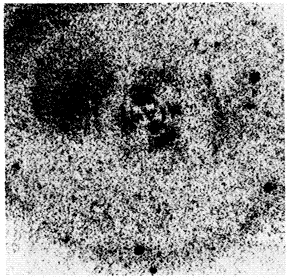 Shell
galaxies are a comparatively recent discovery and are a phenomenon that
is not yet fully understood. Shells may arise as a consequence of low-velocity
galaxy mergers or alternatively be caused by density waves induced by weak
galaxy interactions. Studies - at least in the northern hemisphere - are
hampered by the lack of known shell galaxies. A northern hemisphere programme
has therefore been started by researchers to identify and analyse them
in larger numbers. Using the JKT CCD camera they obtained broad band R
images for a sample of 14 bright ellipticals which had been selected on
the basis of independant evidence for a merger or intercation, such as
extensive dust or kinematically decoupled cores. A new shell-finding algorithm
was employed which subtracts a sophisticated elliptical galaxy model and
detects shells from inspection of residual isophotes. Two of the sample
of 14 were previously known shell galaxies and new shells were discovered
in eight others. Partly because the sample was biased towards positive
detection and partly because of the sensitivity of the CCD technique, the
proportion of shell galaxies detected is much higher than in previous surveys. Shell
galaxies are a comparatively recent discovery and are a phenomenon that
is not yet fully understood. Shells may arise as a consequence of low-velocity
galaxy mergers or alternatively be caused by density waves induced by weak
galaxy interactions. Studies - at least in the northern hemisphere - are
hampered by the lack of known shell galaxies. A northern hemisphere programme
has therefore been started by researchers to identify and analyse them
in larger numbers. Using the JKT CCD camera they obtained broad band R
images for a sample of 14 bright ellipticals which had been selected on
the basis of independant evidence for a merger or intercation, such as
extensive dust or kinematically decoupled cores. A new shell-finding algorithm
was employed which subtracts a sophisticated elliptical galaxy model and
detects shells from inspection of residual isophotes. Two of the sample
of 14 were previously known shell galaxies and new shells were discovered
in eight others. Partly because the sample was biased towards positive
detection and partly because of the sensitivity of the CCD technique, the
proportion of shell galaxies detected is much higher than in previous surveys.
|
| More
information
ING facilities involved:
-
Jacobus Kapteyn Telescope
with CCD camera
Some references:
-
Forbes, D. and Thomson,
R., 1992, "Shells and isophotal distortions in elliptical galaxies", MNRAS,
254,
723
|
|
HALO STARS
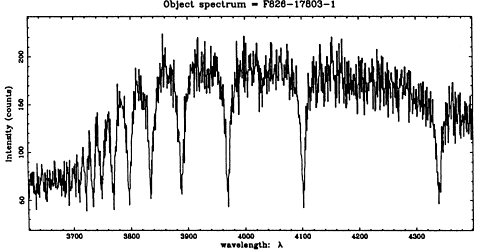 In
our Galaxy, the stars of the stellar halo are amongst the oldest objects
we can observe, and their spatial distribution, kinematics and chemistry
are excellent indicators of the timescale and nature of the early evolution
of the Galaxy. Since the halo stars are influenced by the whole distribution
of the mass of the Galaxy including it's halo of dark matter, they also
provide constraints on both the extent and shape of this mass distribution. In
our Galaxy, the stars of the stellar halo are amongst the oldest objects
we can observe, and their spatial distribution, kinematics and chemistry
are excellent indicators of the timescale and nature of the early evolution
of the Galaxy. Since the halo stars are influenced by the whole distribution
of the mass of the Galaxy including it's halo of dark matter, they also
provide constraints on both the extent and shape of this mass distribution.
One current theory of galaxy formation
suggests that the necessary densities for the formation of halo stars occurred
in dwarf galaxy sized objects which later merged. If this model is correct,
the stellar debris of these initial clumps should now be scattered throughout
the halo and groups of stars should exist on the same orbits as their parents
dust clouds. Most theories also predict considerable later accretion of
halo stars from disrupted satellite galaxies, the remnants of which would
also be on similar orbits. The kinematic streams should be detectable.
Researchers have developed a selection technique to obtain high probability
samples of halo blue horizontal branch (BHB) stars, using both direct and
objective prism UK Schmidt plates scanned by the APM. The technique reliably
eliminates white dwarf stars, quasars, hot subdwarfs and faint galaxies.
44 candidates were selected in this way in two fields using ISIS on the
WHT; they identified 25 stars with A-type spectra in one field and 11 in
another, and determined their velocities and distances. The dispersion
of velocities of four stars in one field at 30kpc from the Sun is very
low, 12 km sec-1, and suggests that these
stars are physically associated and may have had a commonn origin. The
remaining kinematic data show the Galaxy to have a massive halo extending
to at least 30kpc with a flat rotation curve.
|
| More
information
ING facilities involved:
-
William Herschel Telescope,
using ISIS
Some references:
-
Arnold, R and Gilmore,
G., 1992, "Halo blue horizonntal branch stars - Spectroscopy in two fields",
MNRAS,
257,
225
|
|

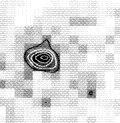 For
some time, astronomers have considered the idea of using Type Ia supernovae
to determine the extragalactic distance scale. Supernovae of this type
occur in the late stages of evolution of a binary system consisting of
a white dwarf star orbiting a companion star. As the companion evolves
to the red giant phase it overflows its Roche Lobe and matter accretes
onto the surface of the white dwarf, gradually increasing the gravitational
pressure. When the white dwarf mass reaches a critical value, the nuclear
fuel ignites explosively. The subsequent growth and decay of light from
the supernova is characteristic of the type, and the intrinisc luminosity
of the explosion is thought to be independent of distance and therefore
usable as a "standard candle". A systematic search for distant supernovae
is being made on the INT as part of an international collaboration by a
team of astronomers.
For
some time, astronomers have considered the idea of using Type Ia supernovae
to determine the extragalactic distance scale. Supernovae of this type
occur in the late stages of evolution of a binary system consisting of
a white dwarf star orbiting a companion star. As the companion evolves
to the red giant phase it overflows its Roche Lobe and matter accretes
onto the surface of the white dwarf, gradually increasing the gravitational
pressure. When the white dwarf mass reaches a critical value, the nuclear
fuel ignites explosively. The subsequent growth and decay of light from
the supernova is characteristic of the type, and the intrinisc luminosity
of the explosion is thought to be independent of distance and therefore
usable as a "standard candle". A systematic search for distant supernovae
is being made on the INT as part of an international collaboration by a
team of astronomers.

